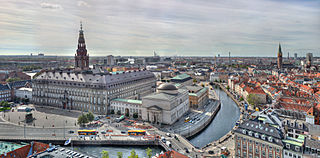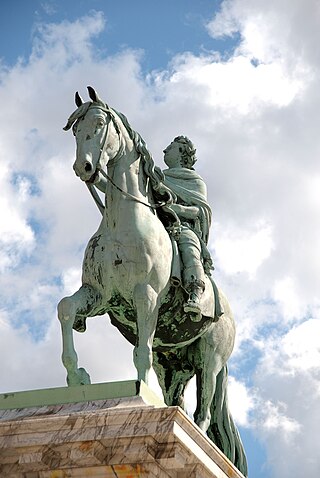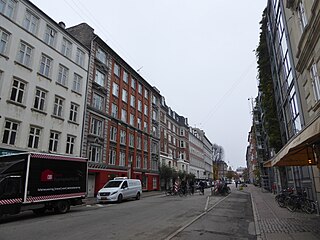
Copenhagen is the capital and most populous city of Denmark, with a population of 1.4 million in the urban area. The city is situated on the islands of Zealand and Amager, separated from Malmö, Sweden, by the Øresund strait. The Øresund Bridge connects the two cities by rail and road.

Nørrebro is one of the 10 official districts of Copenhagen Municipality, Denmark. It is northwest of the city centre, beyond the location of the old Northern Gate (Nørreport), which, until dismantled in 1856, was near the current Nørreport station.

Nørrebro station is an interchange station between the S-train Ring Line and the Copenhagen Metro City Circle Line in the Outer Nørrebro district of Copenhagen, Denmark. It is situated at the junction of Nørrebrogade, Folmer Bendtsens Plads, Frederikssundsvej and Nordre Fasanvej. The functionalist station building from 1930 designed by the architect Knud Tanggaard Seest was listed on the Danish registry of protected buildings and places in 1992.

Olivia Marie Olsen, Liva Weel, was a Danish singer, comedian, and actress. Although she was trained in classical singing, her signature songs and performances were ballads.

Ivar Bentsen was a Danish architect and educator. He was a central figure in the Bedre-Byggeskik movement and succeeded Carl Petersen as a professor at the Royal Danish Academy of Fine Arts's School of Architecture in 1923. He was awarded the C. F. Hansen Medal in 1943.
Nørrebro, Denmark is an active community that nurtures an environment in which creativity is ever-present in daily life.

Iver Eriksen Rosenkrantz was a Danish statesman and landowner.

Prince Charles of Denmark and Norway was the fourth son of Christian V of Denmark and his consort Queen Charlotte Amalie, and thus a younger brother of King Frederick IV. He never married and had no children, nor did he ever engage in any political activities. Instead he maintained a withdrawn life on his estates.

Blågårds Plads is a public square attached to Blågårdsgade, a side street to Nørrebrogade in the Nørrebro district of Copenhagen, Denmark. It is a popular venue for events and various activities in the summer time.

Danish sculpture as a nationally recognized art form can be traced back to 1752 when Jacques Saly was commissioned to execute a statue of King Frederick V of Denmark on horseback. While Bertel Thorvaldsen was undoubtedly the country's most prominent contributor, many other players have produced fine work, especially in the areas of Neoclassicism, Realism, and in Historicism, the latter resulting from growing consciousness of a national identity. More recently, Danish sculpture has been inspired by European trends, especially those from Paris, including Surrealism and Modernism.

The Prince Wilhelm Mansion is a historic property on the corner of Sankt Annæ Plads and Amaliegade in central Copenhagen, Denmark. It is owned by the property investment company Jeudan which is headquartered in the building.

Åboulevard is a street in central Copenhagen, Denmark. Together with H. C. Andersens Boulevard in the city centre and Borups Allé, it forms a major artery in and out of the city. The road is built over Ladegårds Å, a canal originally built to supply Copenhagen with water, which still runs in a pipe under it, feeding water into Peblinge Lake.

Metropolitanskolen was a school in Copenhagen, Denmark founded in 1209 by the Bishop Peder Sunesen, and for centuries one of the most prestigious schools in the country.

Stockholmsgade is a mainly residential street in central Copenhagen, Denmark. It follows the northwestern margin of Østre Anlæg, linking Sølvtorvet in the southwest with Oslo Plads at Østerport station in the northeast. The Hirschsprung Collection, an art museum, is located on the street.
Copenhagen Business Academy, also known as Cphbusiness, is a school of higher education in Copenhagen, Denmark. The academy is an independent self-owning institution subordinated to the Ministry of Science, Innovation and Higher Education. Degree programmes offered are mainly applied degrees, especially in business, finance, service management, IT and biotechnical science. The academy grants undergraduate and academic degrees but not master's or doctoral degrees. In addition to full-time studies the academy offers supplemental education, part-time programmes at bachelor's level and short-term courses for people who need to strengthen their qualifications. The academy is one of the largest business academies in Denmark. The academy has 4.800 full-time students and 5.800 part-time students and about 350 employees.

Rosenørns Allé is a street located on the border between Frederiksberg and Nørrebro, on the west side of The Lakes, in Copenhagen, Denmark. The street branches from the south side of the busy thoroughfare Kampmannsgade-Åboulevard at the west end of the embankment which separates St. Jørgen's Lake from Peblinge Lake, runs west to Julius Thomsens Plads and then continues in a more northwesterly direction to Bülowsvej where it turns into Rolighedsvej and later Godthåbsvej before reaching Bellahøj in Brønshøj.

Guldbergsgade is a street in the Nørrebro district of Copenhagen, Denmark. It follows a clockwise curve from Sankt Hans Torv in the south to Tagensvej in the north. The first part of the street passes the Jewish Northern Cemetery to the west and De Gamles By to the east. The public space Guldbergs Plads with a landscaped playground, is located close to its north end.

Blågårdsgade is a mostly pedestrianized street in the Nørrebro district of Copenhagen, Denmark. It runs from Nørrebrogade in the northeast to Åboulevard in the southwest and passes the square Blågårds Plads. The street is known for its many shops and cafés.

Gyldenløvesgade is a street in central Copenhagen, Denmark. It runs from Jarmers Plads in the south east to a Y junction at the western side of The Lakes, linking H. C. Andersens Boulevard with Aaboulevarden and Rosenørns Allé. The last section of the street runs on an embankment which separates Peblinge Lake to the north from Sankt Jørgen's Lake to the south. The Lake Pavilion overlooks Peblinge Lake on the north side of the street.

Nikolaj Plads 32, also known as Sankt Nicolai Hus, is a property situated on the west side of Nikolaj Plads in Copenhagen, Denmark. It was, like most of the other buildings in the area, constructed as part of the rebuilding of the city following the Copenhagen Fire of 1795. It was listed in the Danish registry of protected buildings and places in 1945. Former residents include the theatrical scenic painter Christian Ferdinand Christensen.



















